FORD F150 2002 10.G Bi Fuel Supplement Manual
Manufacturer: FORD, Model Year: 2002, Model line: F150, Model: FORD F150 2002 10.GPages: 32, PDF Size: 0.51 MB
Page 11 of 32
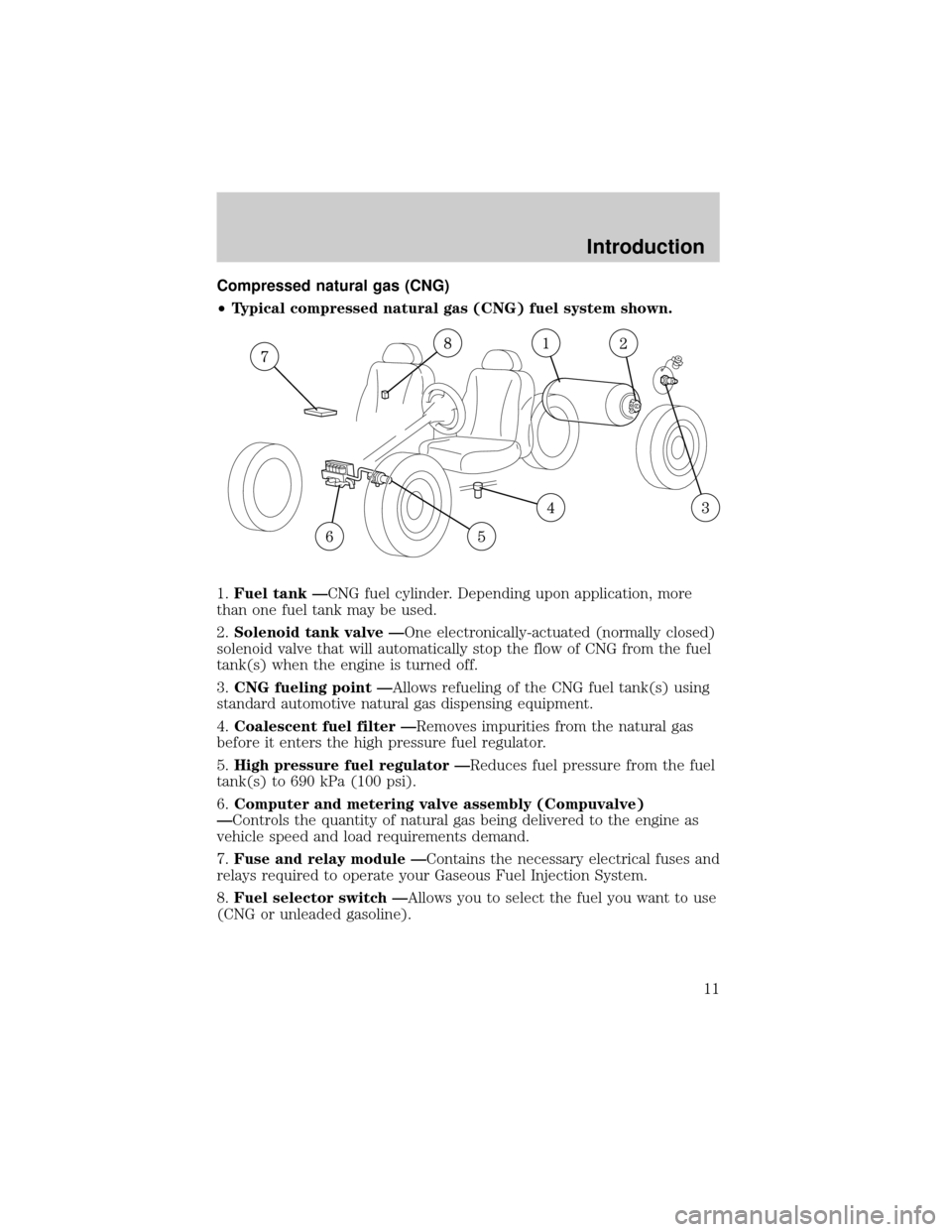
Compressed natural gas (CNG)
²Typical compressed natural gas (CNG) fuel system shown.
1.Fuel tank ÐCNG fuel cylinder. Depending upon application, more
than one fuel tank may be used.
2.Solenoid tank valve ÐOne electronically-actuated (normally closed)
solenoid valve that will automatically stop the flow of CNG from the fuel
tank(s) when the engine is turned off.
3.CNG fueling point ÐAllows refueling of the CNG fuel tank(s) using
standard automotive natural gas dispensing equipment.
4.Coalescent fuel filter ÐRemoves impurities from the natural gas
before it enters the high pressure fuel regulator.
5.High pressure fuel regulator ÐReduces fuel pressure from the fuel
tank(s) to 690 kPa (100 psi).
6.Computer and metering valve assembly (Compuvalve)
ÐControls the quantity of natural gas being delivered to the engine as
vehicle speed and load requirements demand.
7.Fuse and relay module ÐContains the necessary electrical fuses and
relays required to operate your Gaseous Fuel Injection System.
8.Fuel selector switch ÐAllows you to select the fuel you want to use
(CNG or unleaded gasoline).
Introduction
11
Page 12 of 32
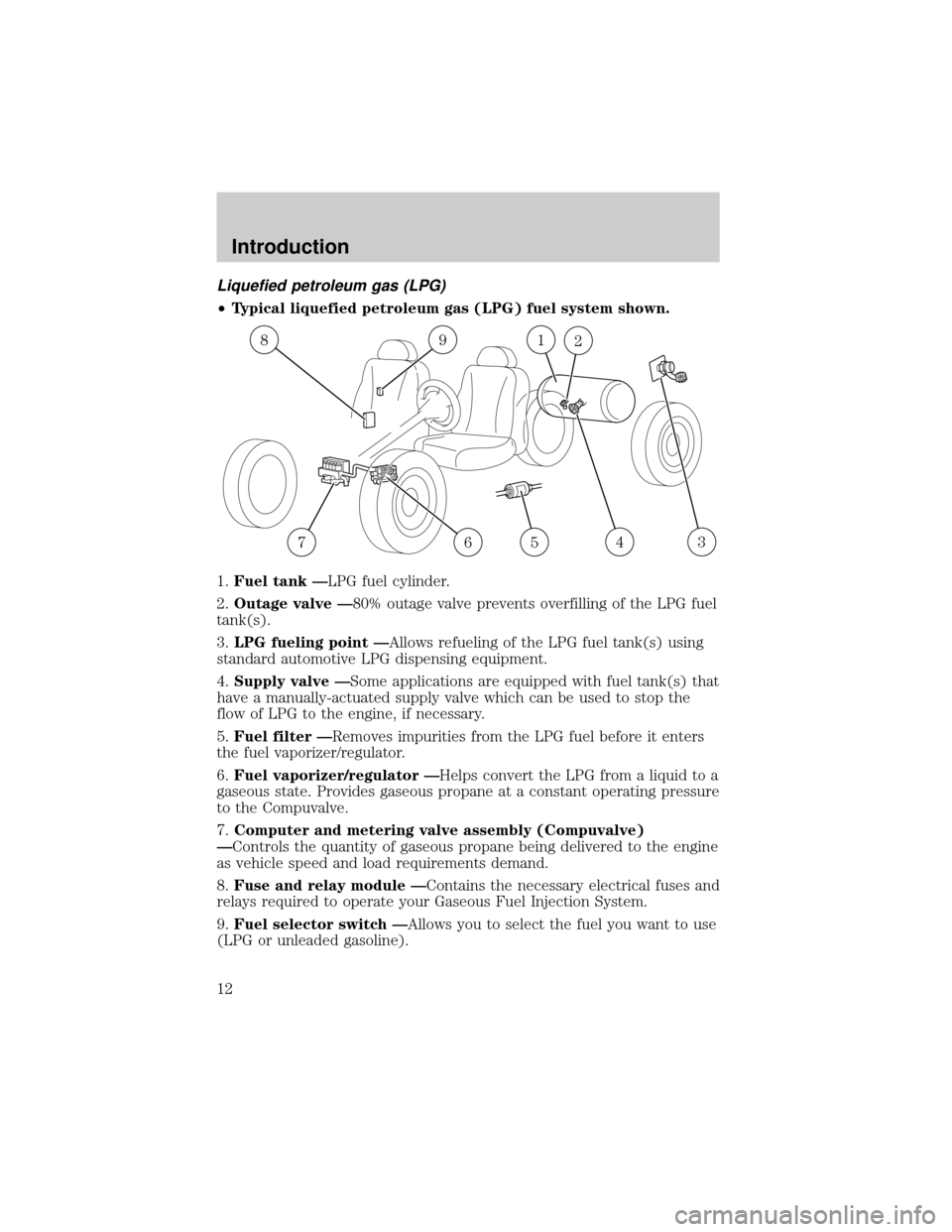
Liquefied petroleum gas (LPG)
²Typical liquefied petroleum gas (LPG) fuel system shown.
1.Fuel tank ÐLPG fuel cylinder.
2.Outage valve Ð80% outage valve prevents overfilling of the LPG fuel
tank(s).
3.LPG fueling point ÐAllows refueling of the LPG fuel tank(s) using
standard automotive LPG dispensing equipment.
4.Supply valve ÐSome applications are equipped with fuel tank(s) that
have a manually-actuated supply valve which can be used to stop the
flow of LPG to the engine, if necessary.
5.Fuel filter ÐRemoves impurities from the LPG fuel before it enters
the fuel vaporizer/regulator.
6.Fuel vaporizer/regulator ÐHelps convert the LPG from a liquid to a
gaseous state. Provides gaseous propane at a constant operating pressure
to the Compuvalve.
7.Computer and metering valve assembly (Compuvalve)
ÐControls the quantity of gaseous propane being delivered to the engine
as vehicle speed and load requirements demand.
8.Fuse and relay module ÐContains the necessary electrical fuses and
relays required to operate your Gaseous Fuel Injection System.
9.Fuel selector switch ÐAllows you to select the fuel you want to use
(LPG or unleaded gasoline).
192
35467
8
Introduction
12
Page 13 of 32
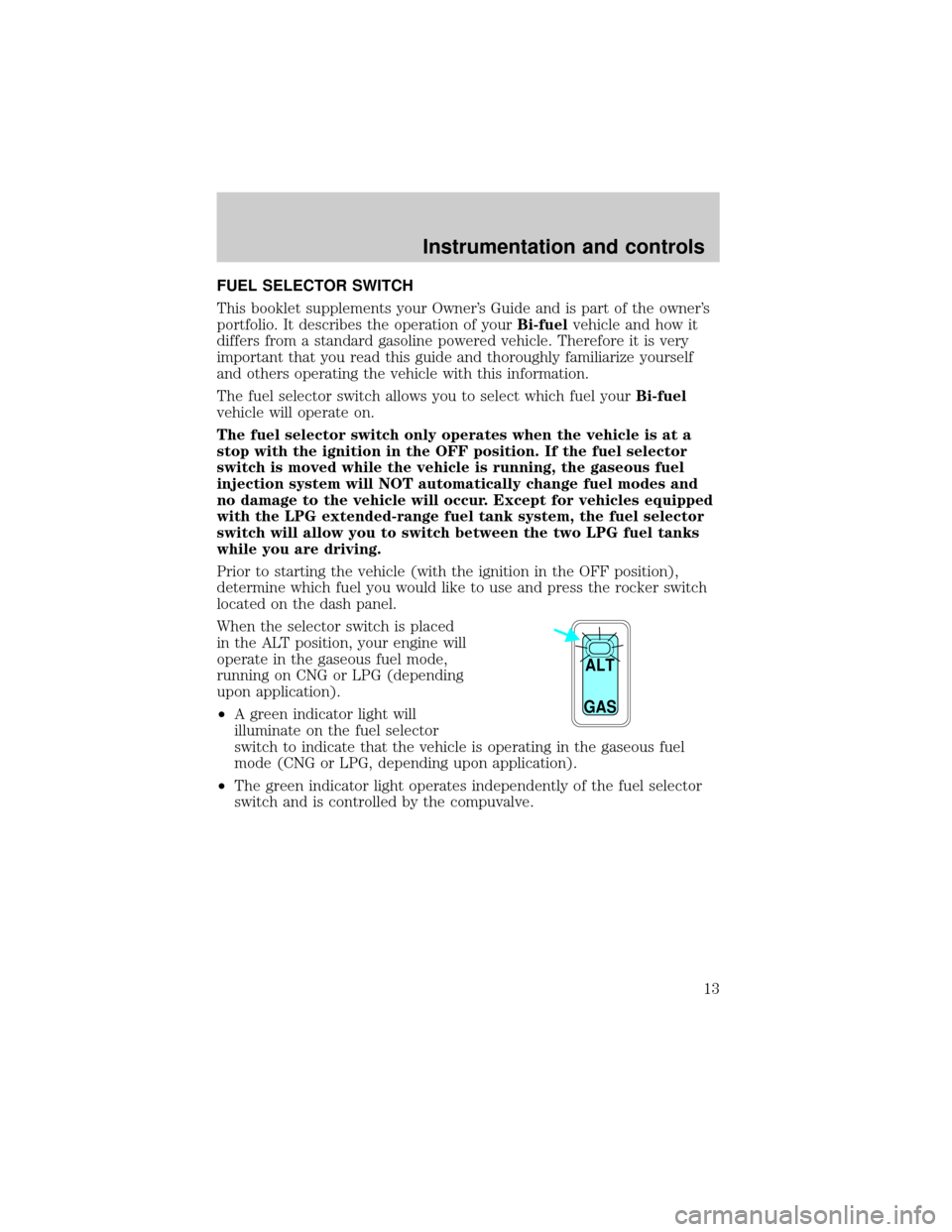
FUEL SELECTOR SWITCH
This booklet supplements your Owner's Guide and is part of the owner's
portfolio. It describes the operation of yourBi-fuelvehicle and how it
differs from a standard gasoline powered vehicle. Therefore it is very
important that you read this guide and thoroughly familiarize yourself
and others operating the vehicle with this information.
The fuel selector switch allows you to select which fuel yourBi-fuel
vehicle will operate on.
The fuel selector switch only operates when the vehicle is at a
stop with the ignition in the OFF position. If the fuel selector
switch is moved while the vehicle is running, the gaseous fuel
injection system will NOT automatically change fuel modes and
no damage to the vehicle will occur. Except for vehicles equipped
with the LPG extended-range fuel tank system, the fuel selector
switch will allow you to switch between the two LPG fuel tanks
while you are driving.
Prior to starting the vehicle (with the ignition in the OFF position),
determine which fuel you would like to use and press the rocker switch
located on the dash panel.
When the selector switch is placed
in the ALT position, your engine will
operate in the gaseous fuel mode,
running on CNG or LPG (depending
upon application).
²A green indicator light will
illuminate on the fuel selector
switch to indicate that the vehicle is operating in the gaseous fuel
mode (CNG or LPG, depending upon application).
²The green indicator light operates independently of the fuel selector
switch and is controlled by the compuvalve.
ALT
GAS
Instrumentation and controls
13
Page 14 of 32
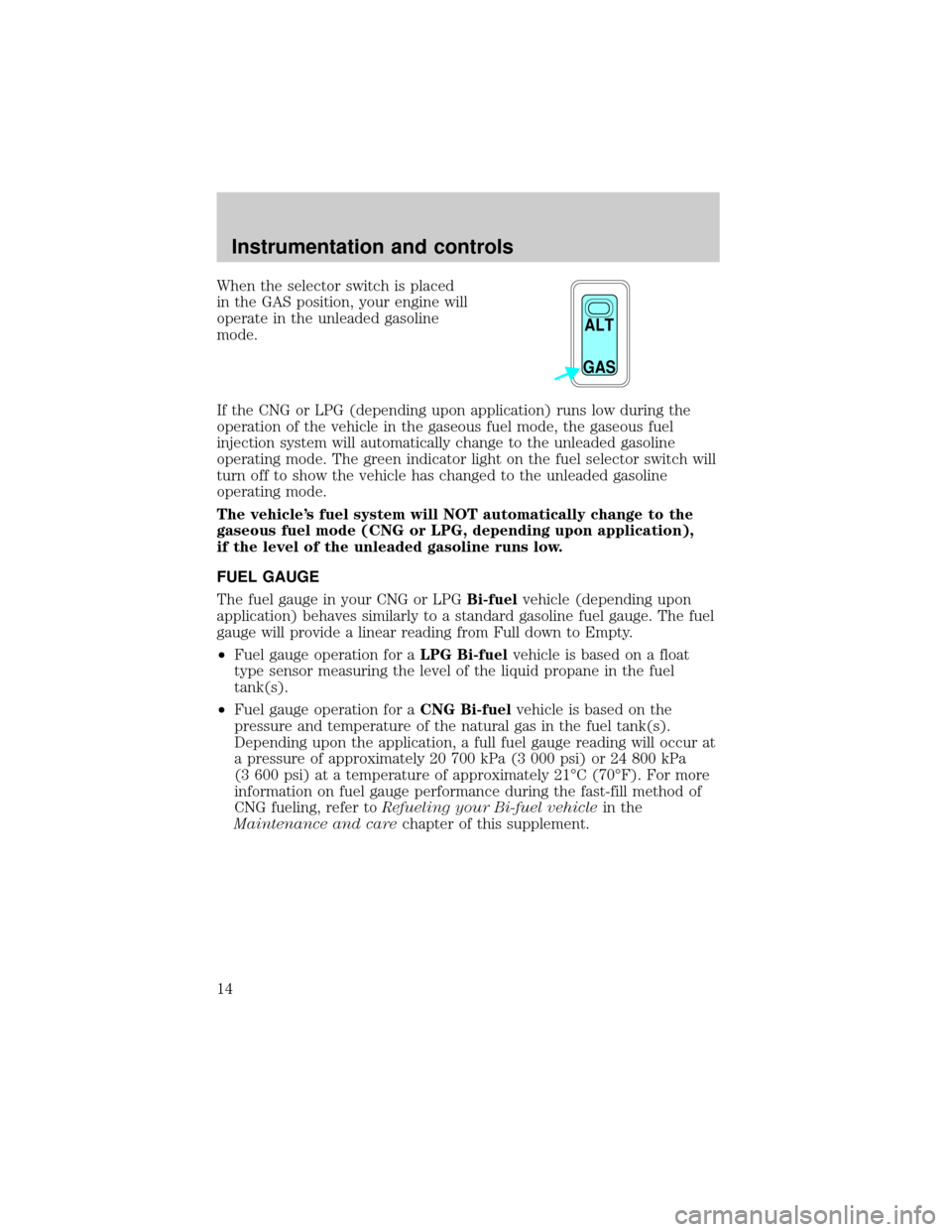
When the selector switch is placed
in the GAS position, your engine will
operate in the unleaded gasoline
mode.
If the CNG or LPG (depending upon application) runs low during the
operation of the vehicle in the gaseous fuel mode, the gaseous fuel
injection system will automatically change to the unleaded gasoline
operating mode. The green indicator light on the fuel selector switch will
turn off to show the vehicle has changed to the unleaded gasoline
operating mode.
The vehicle's fuel system will NOT automatically change to the
gaseous fuel mode (CNG or LPG, depending upon application),
if the level of the unleaded gasoline runs low.
FUEL GAUGE
The fuel gauge in your CNG or LPGBi-fuelvehicle (depending upon
application) behaves similarly to a standard gasoline fuel gauge. The fuel
gauge will provide a linear reading from Full down to Empty.
²Fuel gauge operation for aLPG Bi-fuelvehicle is based on a float
type sensor measuring the level of the liquid propane in the fuel
tank(s).
²Fuel gauge operation for aCNG Bi-fuelvehicle is based on the
pressure and temperature of the natural gas in the fuel tank(s).
Depending upon the application, a full fuel gauge reading will occur at
a pressure of approximately 20 700 kPa (3 000 psi) or 24 800 kPa
(3 600 psi) at a temperature of approximately 21ÉC (70ÉF). For more
information on fuel gauge performance during the fast-fill method of
CNG fueling, refer toRefueling your Bi-fuel vehiclein the
Maintenance and carechapter of this supplement.
ALT
GAS
Instrumentation and controls
14
Page 15 of 32
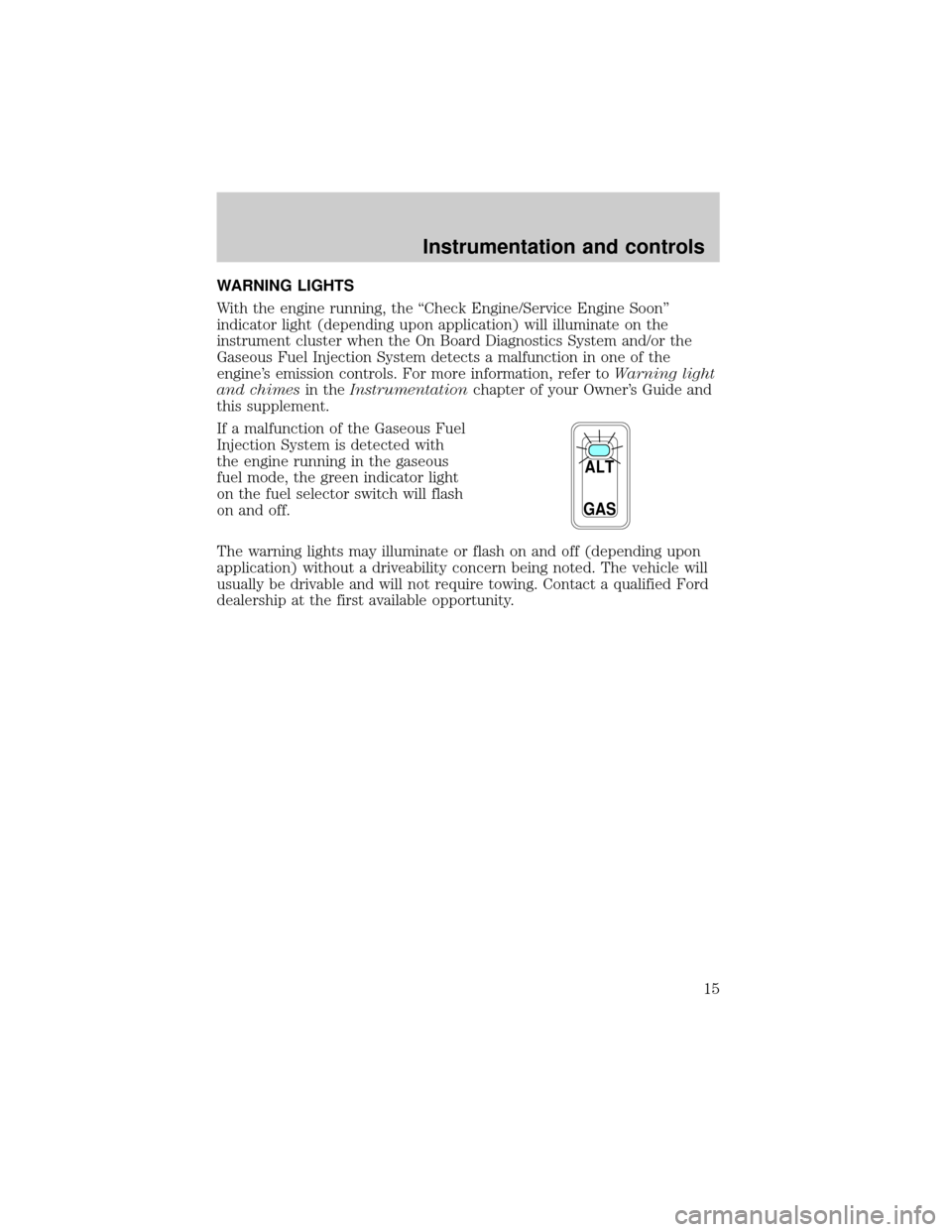
WARNING LIGHTS
With the engine running, the ªCheck Engine/Service Engine Soonº
indicator light (depending upon application) will illuminate on the
instrument cluster when the On Board Diagnostics System and/or the
Gaseous Fuel Injection System detects a malfunction in one of the
engine's emission controls. For more information, refer toWarning light
and chimesin theInstrumentationchapter of your Owner's Guide and
this supplement.
If a malfunction of the Gaseous Fuel
Injection System is detected with
the engine running in the gaseous
fuel mode, the green indicator light
on the fuel selector switch will flash
on and off.
The warning lights may illuminate or flash on and off (depending upon
application) without a driveability concern being noted. The vehicle will
usually be drivable and will not require towing. Contact a qualified Ford
dealership at the first available opportunity.
GASALT
Instrumentation and controls
15
Page 16 of 32
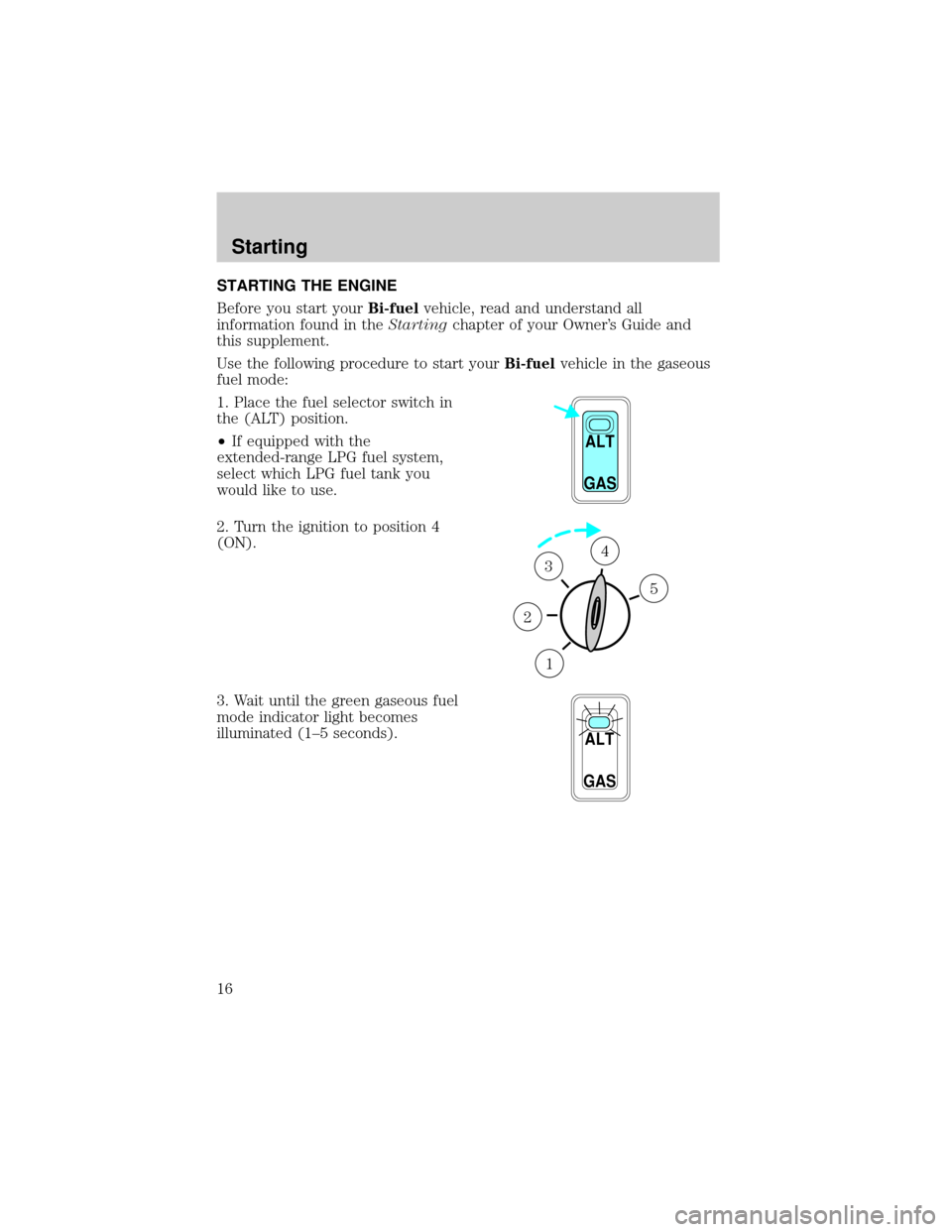
STARTING THE ENGINE
Before you start yourBi-fuelvehicle, read and understand all
information found in theStartingchapter of your Owner's Guide and
this supplement.
Use the following procedure to start yourBi-fuelvehicle in the gaseous
fuel mode:
1. Place the fuel selector switch in
the (ALT) position.
²If equipped with the
extended-range LPG fuel system,
select which LPG fuel tank you
would like to use.
2. Turn the ignition to position 4
(ON).
3. Wait until the green gaseous fuel
mode indicator light becomes
illuminated (1±5 seconds).
ALT
GAS
1
2
34
5
GASALT
Starting
16
Page 17 of 32
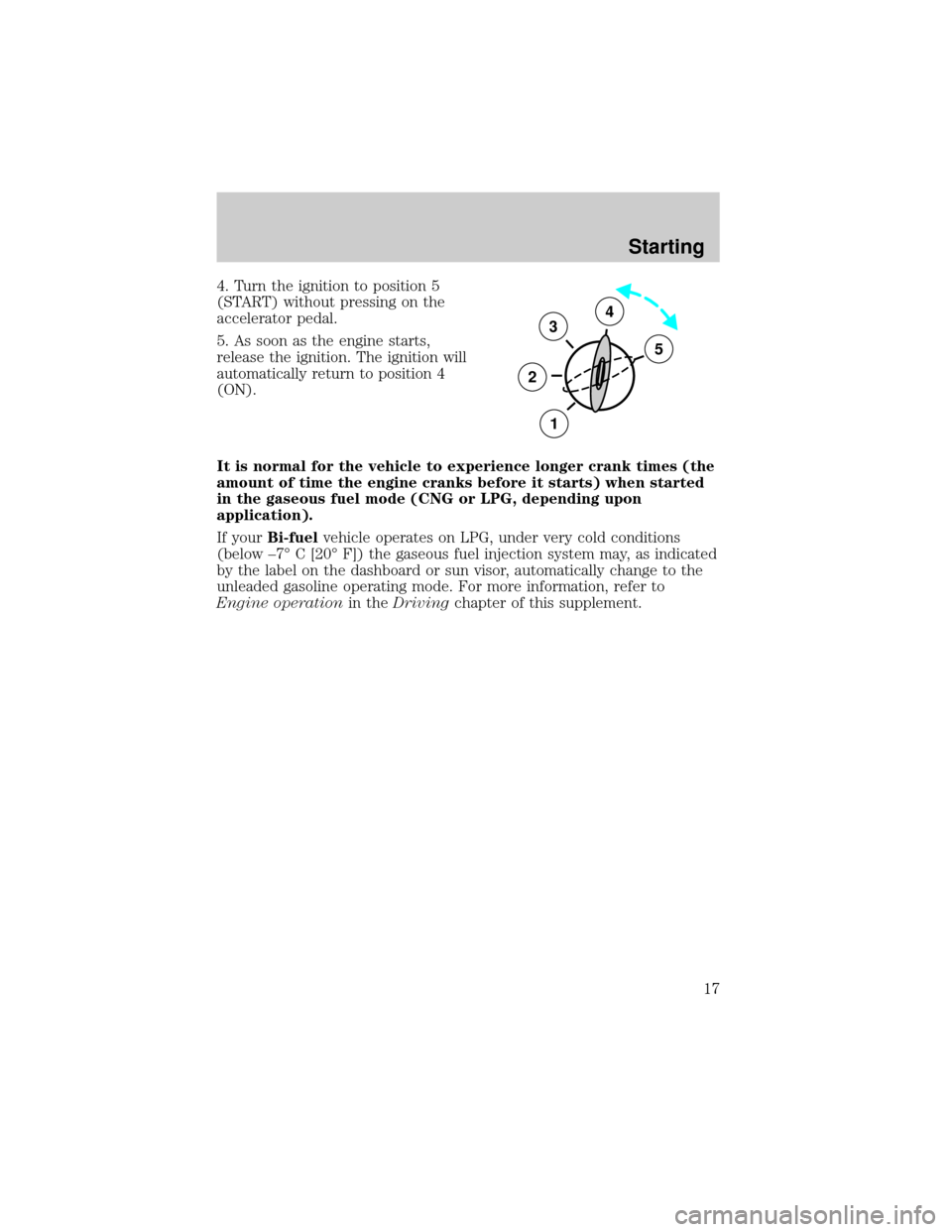
4. Turn the ignition to position 5
(START) without pressing on the
accelerator pedal.
5. As soon as the engine starts,
release the ignition. The ignition will
automatically return to position 4
(ON).
It is normal for the vehicle to experience longer crank times (the
amount of time the engine cranks before it starts) when started
in the gaseous fuel mode (CNG or LPG, depending upon
application).
If yourBi-fuelvehicle operates on LPG, under very cold conditions
(below ±7É C [20É F]) the gaseous fuel injection system may, as indicated
by the label on the dashboard or sun visor, automatically change to the
unleaded gasoline operating mode. For more information, refer to
Engine operationin theDrivingchapter of this supplement.
3
2
1
5
4
Starting
17
Page 18 of 32
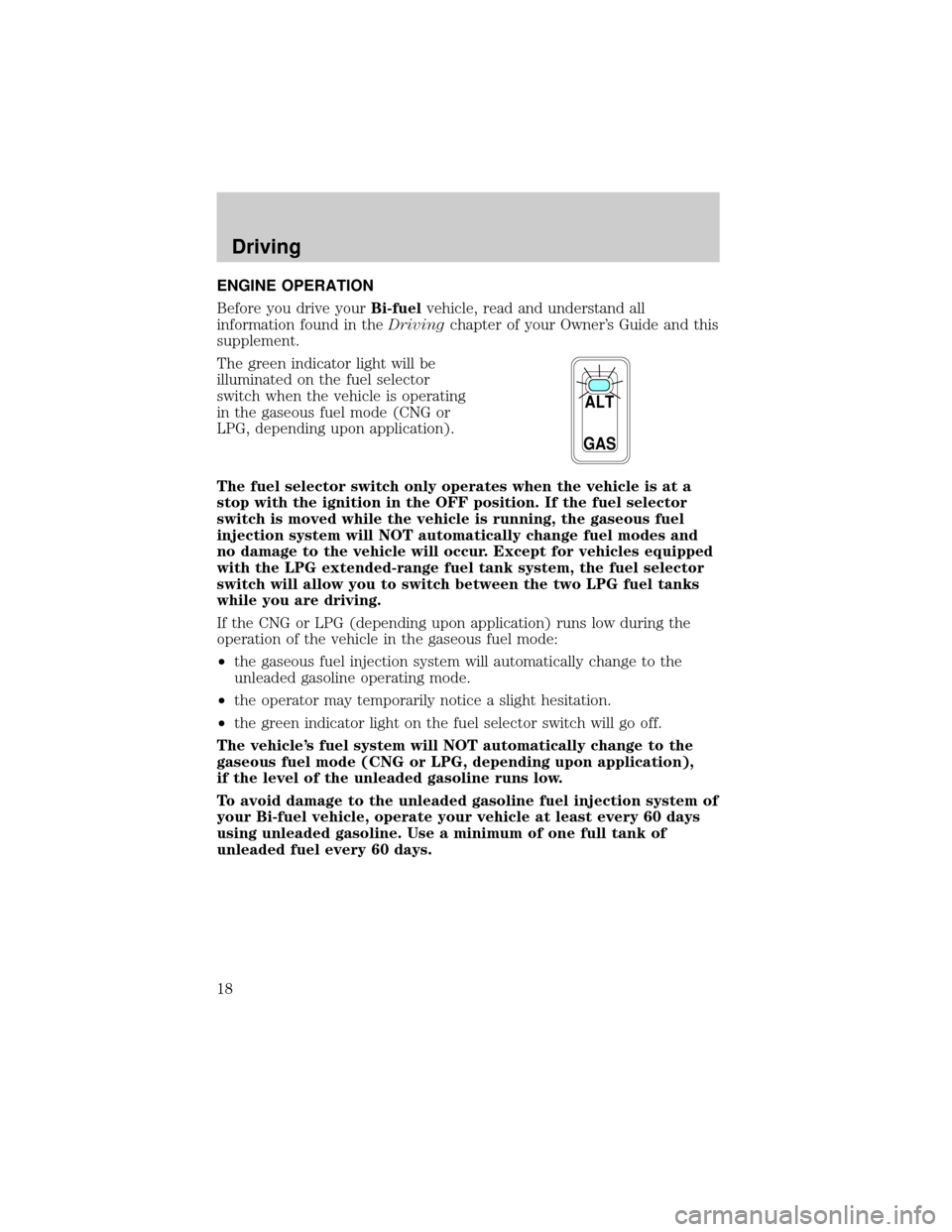
ENGINE OPERATION
Before you drive yourBi-fuelvehicle, read and understand all
information found in theDrivingchapter of your Owner's Guide and this
supplement.
The green indicator light will be
illuminated on the fuel selector
switch when the vehicle is operating
in the gaseous fuel mode (CNG or
LPG, depending upon application).
The fuel selector switch only operates when the vehicle is at a
stop with the ignition in the OFF position. If the fuel selector
switch is moved while the vehicle is running, the gaseous fuel
injection system will NOT automatically change fuel modes and
no damage to the vehicle will occur. Except for vehicles equipped
with the LPG extended-range fuel tank system, the fuel selector
switch will allow you to switch between the two LPG fuel tanks
while you are driving.
If the CNG or LPG (depending upon application) runs low during the
operation of the vehicle in the gaseous fuel mode:
²the gaseous fuel injection system will automatically change to the
unleaded gasoline operating mode.
²the operator may temporarily notice a slight hesitation.
²the green indicator light on the fuel selector switch will go off.
The vehicle's fuel system will NOT automatically change to the
gaseous fuel mode (CNG or LPG, depending upon application),
if the level of the unleaded gasoline runs low.
To avoid damage to the unleaded gasoline fuel injection system of
your Bi-fuel vehicle, operate your vehicle at least every 60 days
using unleaded gasoline. Use a minimum of one full tank of
unleaded fuel every 60 days.
GASALT
Driving
18
Page 19 of 32

The characteristics of LPG are unique from those of CNG, unleaded
gasoline and diesel fuel. If yourBi-fuelvehicle operates on LPG, the
gaseous fuel injection system may, as indicated by the label on the
dashboard or the sun visor, automatically change to the unleaded
gasoline operating mode under certain conditions in very cold
temperatures (below ±7É C [20É F]).
If you expect to operate your LPG Bi-fuel vehicle in very cold
temperatures, be sure to maintain an adequate supply of
unleaded gasoline in the fuel tank.
TRAILER TOWING WITH YOUR BI-FUEL VEHICLE
Refer toTowing a trailerin theDrivingchapter of the Owner's Guide
for trailer towing procedures.
Driving
19
Page 20 of 32
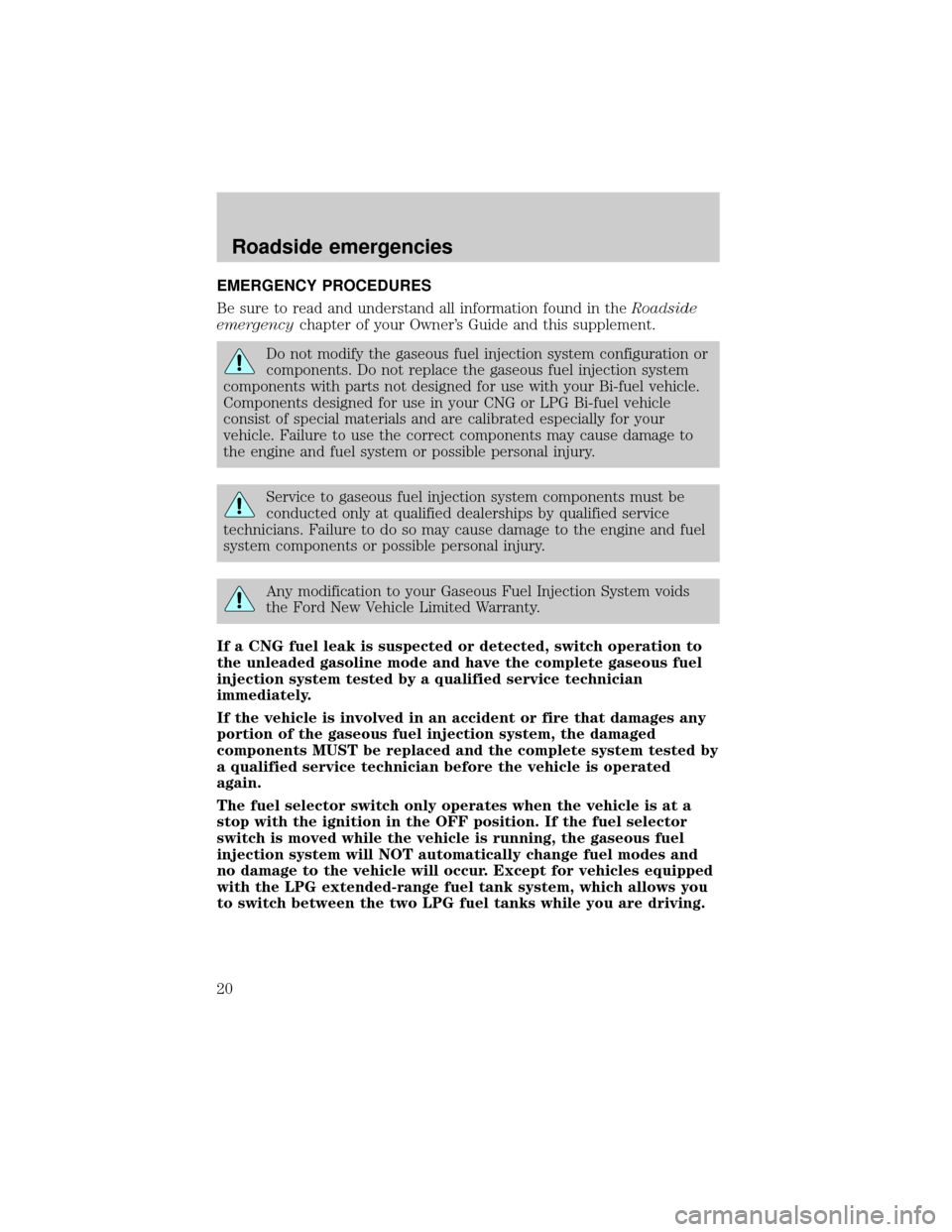
EMERGENCY PROCEDURES
Be sure to read and understand all information found in theRoadside
emergencychapter of your Owner's Guide and this supplement.
Do not modify the gaseous fuel injection system configuration or
components. Do not replace the gaseous fuel injection system
components with parts not designed for use with your Bi-fuel vehicle.
Components designed for use in your CNG or LPG Bi-fuel vehicle
consist of special materials and are calibrated especially for your
vehicle. Failure to use the correct components may cause damage to
the engine and fuel system or possible personal injury.
Service to gaseous fuel injection system components must be
conducted only at qualified dealerships by qualified service
technicians. Failure to do so may cause damage to the engine and fuel
system components or possible personal injury.
Any modification to your Gaseous Fuel Injection System voids
the Ford New Vehicle Limited Warranty.
If a CNG fuel leak is suspected or detected, switch operation to
the unleaded gasoline mode and have the complete gaseous fuel
injection system tested by a qualified service technician
immediately.
If the vehicle is involved in an accident or fire that damages any
portion of the gaseous fuel injection system, the damaged
components MUST be replaced and the complete system tested by
a qualified service technician before the vehicle is operated
again.
The fuel selector switch only operates when the vehicle is at a
stop with the ignition in the OFF position. If the fuel selector
switch is moved while the vehicle is running, the gaseous fuel
injection system will NOT automatically change fuel modes and
no damage to the vehicle will occur. Except for vehicles equipped
with the LPG extended-range fuel tank system, which allows you
to switch between the two LPG fuel tanks while you are driving.
Roadside emergencies
20